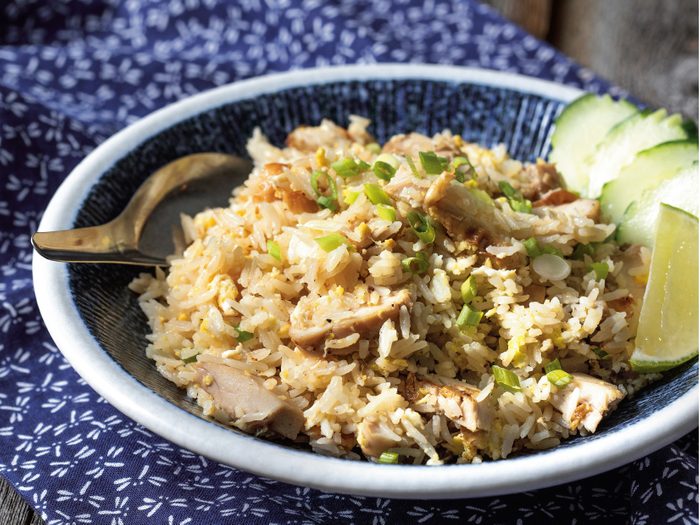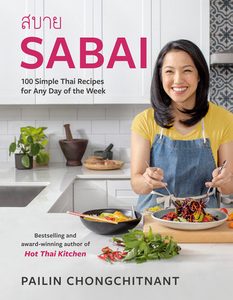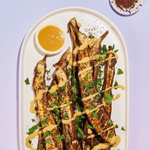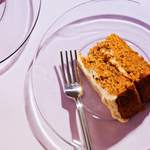How to Make Egg Fried Rice (And Use Up Fridge Leftovers)

A recipe for fried rice, excerpted from the cookbook Sabai by Pailin Chongchitnant
Fried rice is for Thai people what pizza is for North Americans: a standard base that you can then top with just about anything, making it the ideal dish for using up leftover bits of meat and veg. But unlike pizza, fried rice is easy and fast to make! A basic fried rice recipe such as this one is a good tool to have in your back pocket, and it will work with any protein, even strongly flavored ones. We don’t usually add veggies to our basic fried rice, but to serve it Thai style, you’ve got to have fresh cucumber slices, a lime wedge, and some prik nam pla on the side!
Leftover Anything Fried Rice
Kao Pad Kong Leua | ข้าวผัดของเหลือ
Serves 2
Cook time: 5 minutes
Ingredients
- 2 tablespoons (30 ml) neutral oil
- 6 cloves (30 g) garlic, chopped
- 2 large eggs
- 2½ cups (375 g) cooked jasmine rice (see sidebar on p. 203)
- 1 tablespoon (15 ml) soy sauce, preferably Thai (use a bit less if your leftovers are salty)
- 2 teaspoons (10 ml) fish sauce
- 1 teaspoon (5 ml) granulated sugar
- ¼ teaspoon (1 ml) ground white pepper
- 4.6 ounces (130 g) leftover protein, shredded or chopped
- 1 green onion and/or 4 to 6 sprigs cilantro, chopped
For serving
- English cucumber slices Lime wedges
- Prik nam pla (fish sauce & chilies condiment)
Directions
Place a wok on medium heat and add the oil and garlic. Once the garlic bubbles, stir for 1 to 2 minutes, until the smallest pieces start to turn golden.
Add the eggs, scramble slightly, then let them set about halfway before stirring to break up the pieces.
Turn the heat up to high, then add the rice, soy sauce, fish sauce, sugar, and pepper; toss to distribute the sauce evenly.
Add the protein and toss to mix, then let the rice sit without stirring for 10 to 15 seconds so that it can toast and develop some browning and flavor. Toss to mix and repeat this toasting step a few more times. Turn off the heat, then taste and adjust the seasoning.
Toss in the green onions and/or cilantro to taste, then plate and garnish with more fresh herbs, if desired. Serve with cucumber slices, lime wedges, and some prik nam pla, if you wish.
Tip 1: Use Those Drippings! I first used this recipe with leftover supermarket rotisserie chicken, and if you’ve ever had rotisserie chicken, you’ll know that at the bottom of the container lie delicious chicken juices. And the same might be true with whatever leftover meats you have—drippings or juices sitting at the bottom of the plate. This is liquid gold that should absolutely go into your fried rice. However, be mindful of how salty the liquid is, and cut down on the soy sauce or fish sauce accordingly. Also, don’t add more than 2 to 3 tablespoons (30 to 45 ml) liquid for this recipe, so as to not make it too wet.
Tip 2: Old, cold rice for fried rice is great, but you don’t need it. If cooking fresh rice, wash the rice at least three times, until the water runs clear, then use a little bit less water to cook it than you normally would (I do a one-to-one ratio for jasmine rice). If you have time, spread the rice out onto a plate to let it dry out before cooking. I also recommend weighing the cooked rice for accuracy, but if measuring by cup, press the rice in just enough so there aren’t any big gaps, but do not pack it tightly. Finally, if you don’t have a large wok, I recommend cooking in two batches to maximize rice toasting, though you can cook all the protein at once.

Excerpted from Sabai by Pailin Chongchitnant. Copyright © 2023 Pailin Chongchitnant. Photographs by Janis Nicolay. Published by Appetite by Random House®, a division of Penguin Random House Canada Limited. Reproduced by arrangement with the Publisher. All rights reserved.




